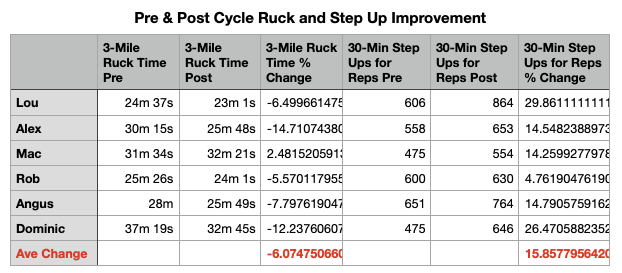By Rob Shaul
BLUF
This 3.5-week Mini-Study investigated the transfer of loaded step ups to rucking.
Six remote, lab rats completed the 3.5 Week study which began with a 3-Mile Ruck for Time carrying a 40-pound ruck. After a days’ rest, the lab rats completed a 30-minute Step Up for Reps Assessment wearing a 40-pound ruck and using a 12-16″ box or bench.
Over the next three weeks, the lab rats completed the same training plan, which was focused on an internal-based step up progression based on their initial step up assessment results.
At the end of 3 weeks, the lab rats re-assessed the 3-mile ruck at 40-pounds and a 30-minute step up for time assessment wearing a 40-pound ruck and using a 12-16″ box or step.
Post cycle, the lab rats averaged a 6% decrease in 3-Mile ruck time, but a 15.9% increase in step ups for the 30-minute assessment.
The results question the effectiveness of step ups to improve rucking speed. Clearly, doing step ups make you better at step ups, but the transfer to rucking is questionable.
BACKGROUND & STUDY DESIGN
In a previous effort we studied the transfer of biking to improving uphill movement under load and found little transfer. In another previous mini study, we found that rowing transfers slightly better to running than running transfers to rowing.
Common sense reasons that if you want to improve rucking speed, best would be to ruck, so why then test if step ups can improve rucking speed? Two reasons: (1) Sometimes weather and or location may impact the ability of an athlete to ruck. An example might include a US Marine on shipboard deployment.
Second, to address the “burden of constant fitness” and the corresponding training “staleness” for military athletes. Offering a variety in exercise modes which still transfer to mission direct demands (rucking in this case) helps keep training from becoming “stale” for tactical athletes.
The six lab rats for this study began the work with a ruck and step up assessment, then followed an interval step up progressed based on their assessment results. After 3 weeks of training, they repeated the ruck and step up assessment.
Below was the non-assessment weekly schedule:
- Mon: Step Up Intervals
- Tue: Upper Body Strength, Chassis Integrity
- Wed: Step Up Intervals
- Thur: Upper Body Strength, Chassis Integrity
- Fri: Step Up Intervals
- Sat: Rest or outdoor recreation
- Sun: Rest or outdoor recreation
RESULTS & DISCUSSION
Below are the mini-study results:
While the lab rats did improve on their ruck run performance, the bulk of the 6% overall average faster time could simply be attributed to familiarity with the 3-mile ruck assessment, and not necessary any transferable fitness gain from doing 3 weeks of step up intervals.
However, the near 16% average increase in step up assessment results mirrors what we’ve seen many times from MTI lab rats completing focused, mode-specific programming.
As with all studies, there are some concerns with this study design. In our previous study assessing the transferability of rowing to running, we split the lab rats into two groups, where one group completed a running progression and the second group completed a rowing progression. That study design allowed us to not only study the transferability of rowing to running, but also clearly demonstrate how much better running improves running, in comparison to rowing. We didn’t split the lab rats for this study, so we can’t make that direct comparison.
NEXT STEPS
While this may seem like an obvious study result, the search for mode transfer is justified and we’ll continue to test the transfer of one endurance mode to performance in another.
Questions? Email coach@mtntactical.com
Comments? Please enter your comment below.
You Might Also Like Geek Cycle: Leg Blasters Match Front Squat in Building Lower Body Strength
STAY UPDATED
Sign-up for our BETA newsletter. Training tips, research updates, videos and articles - and we’ll never sell your info.


